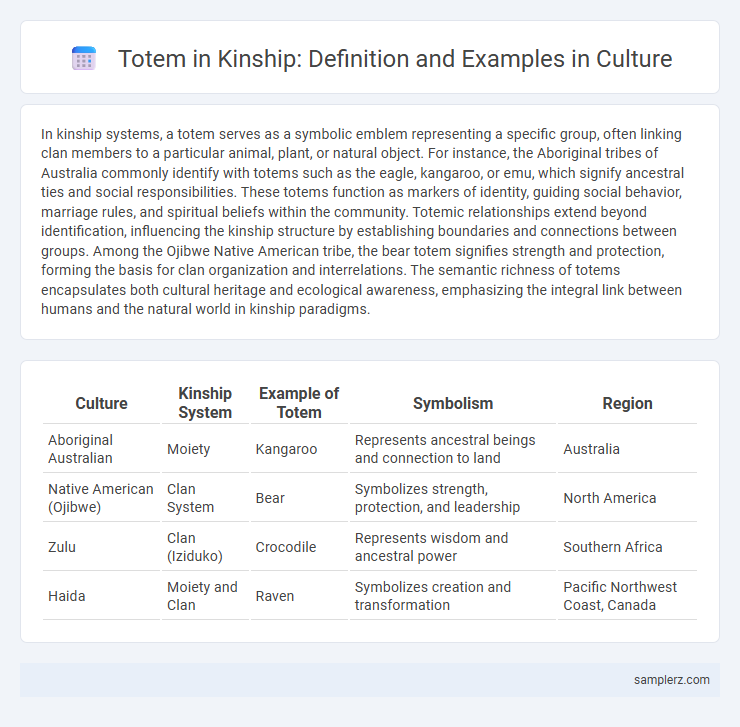In kinship systems, a totem serves as a symbolic emblem representing a specific group, often linking clan members to a particular animal, plant, or natural object. For instance, the Aboriginal tribes of Australia commonly identify with totems such as the eagle, kangaroo, or emu, which signify ancestral ties and social responsibilities. These totems function as markers of identity, guiding social behavior, marriage rules, and spiritual beliefs within the community. Totemic relationships extend beyond identification, influencing the kinship structure by establishing boundaries and connections between groups. Among the Ojibwe Native American tribe, the bear totem signifies strength and protection, forming the basis for clan organization and interrelations. The semantic richness of totems encapsulates both cultural heritage and ecological awareness, emphasizing the integral link between humans and the natural world in kinship paradigms.
Table of Comparison
| Culture | Kinship System | Example of Totem | Symbolism | Region |
|---|---|---|---|---|
| Aboriginal Australian | Moiety | Kangaroo | Represents ancestral beings and connection to land | Australia |
| Native American (Ojibwe) | Clan System | Bear | Symbolizes strength, protection, and leadership | North America |
| Zulu | Clan (Iziduko) | Crocodile | Represents wisdom and ancestral power | Southern Africa |
| Haida | Moiety and Clan | Raven | Symbolizes creation and transformation | Pacific Northwest Coast, Canada |
Introduction to Totems in Kinship Systems
Totems in kinship systems serve as symbolic emblems representing clans or family groups, often linked to animals, plants, or natural objects that embody lineage identity. These emblems function in social organization by establishing group cohesion, guiding marital rules, and maintaining ancestral heritage. Anthropological studies highlight totems as integral to cultural continuity and spiritual beliefs within indigenous communities globally.
Historical Origins of Totemism
Totemism originated in indigenous societies where clans identified with specific natural objects or animals symbolizing ancestral lineage and spiritual connection. Historical evidence from Aboriginal Australian and Native American cultures reveals that totems functioned as emblems of kinship, social order, and cosmological beliefs. Archaeological findings and ethnographic studies demonstrate that totemic systems reinforced group identity and regulated intergroup relationships through ritualistic practices.
Symbolic Meaning of Totems in Different Cultures
Totems in kinship systems often symbolize ancestral lineage and spiritual connection, serving as powerful emblems of identity and collective memory. In Indigenous Australian cultures, animal totems like the kangaroo or eagle represent clan heritage and guide social behavior while fostering respect for nature. Similarly, among the Native American Ojibwe, bear and wolf totems embody strength, protection, and wisdom, reinforcing community bonds and moral values.
Common Types of Totems Among Kinship Groups
Totems among kinship groups often include animals, plants, and natural elements that symbolize clan identity and spiritual connection. Common types of totems in various cultures include the eagle, representing strength and freedom, the bear symbolizing protection and courage, and the oak tree embodying endurance and stability. These totems serve as emblems for lineage, guiding social behaviors, rituals, and kinship roles within the community.
Totem Clan Structures and Organization
Totem clan structures organize social groups by linking members to a shared emblematic animal or natural element that symbolizes their ancestry and identity. These totems serve as integral markers for establishing kinship ties, guiding marriage rules, and preserving oral histories within indigenous communities. Clan organization based on totems reinforces social cohesion and cultural continuity by delineating responsibilities and spiritual connections among members.
Role of Totems in Regulating Marriage and Social Behavior
Totems serve as symbolic emblems representing clans or kinship groups, guiding social norms and regulating marriage by prohibiting unions within the same totem group to prevent inbreeding. These totemic restrictions reinforce social cohesion and delineate boundaries of kinship, promoting alliances between different clans. Through shared rituals and taboos linked to totems, communities maintain order and transmit cultural values across generations.
Totem-Based Myths and Ancestral Narratives
Totem-based myths serve as foundational elements in kinship systems, linking clans to specific animals, plants, or natural phenomena that symbolize ancestral origins and spiritual connections. These narratives encode moral codes, social structures, and collective identity, reinforcing the bond between members and their environment. Examples include the Raven in Pacific Northwest Indigenous cultures, whose tales explain creation and social order through ancestral lineage.
Case Studies: Totems in Australian Aboriginal Societies
Australian Aboriginal societies utilize totems as vital symbols in kinship systems, where each clan or family group identifies with a specific animal, plant, or natural element to represent ancestry and spiritual connection. The Yolngu people of Arnhem Land, for example, associate with totems like the kangaroo or the watersnake, reflecting their deep relationship to the environment and social structure. These totems govern social responsibilities, marriage rules, and ceremonial practices, reinforcing communal identity and ecological stewardship.
Transformation of Totem Practices in Modern Times
Totem practices in kinship have transformed significantly in modern times, shifting from rigid clan symbols to more fluid and personalized expressions of identity. Contemporary societies often reinterpret traditional totems through art, digital media, and community events, reflecting evolving cultural values and individual connections. This transformation highlights the dynamic interplay between heritage preservation and modern innovation within kinship systems.
The Significance of Totems in Preserving Cultural Identity
Totems, such as the eagle for the Haida people or the wolf for the Ojibwe, serve as powerful symbols in kinship systems that preserve cultural identity by linking individuals to ancestral heritage and spiritual beliefs. These totems function as emblematic representations of clan lineage, reinforcing social cohesion and transmitting traditional knowledge across generations. The enduring presence of totemic symbols in rituals, art, and oral histories sustains collective memory and strengthens community bonds within indigenous cultures.

example of totem in kinship Infographic
 samplerz.com
samplerz.com